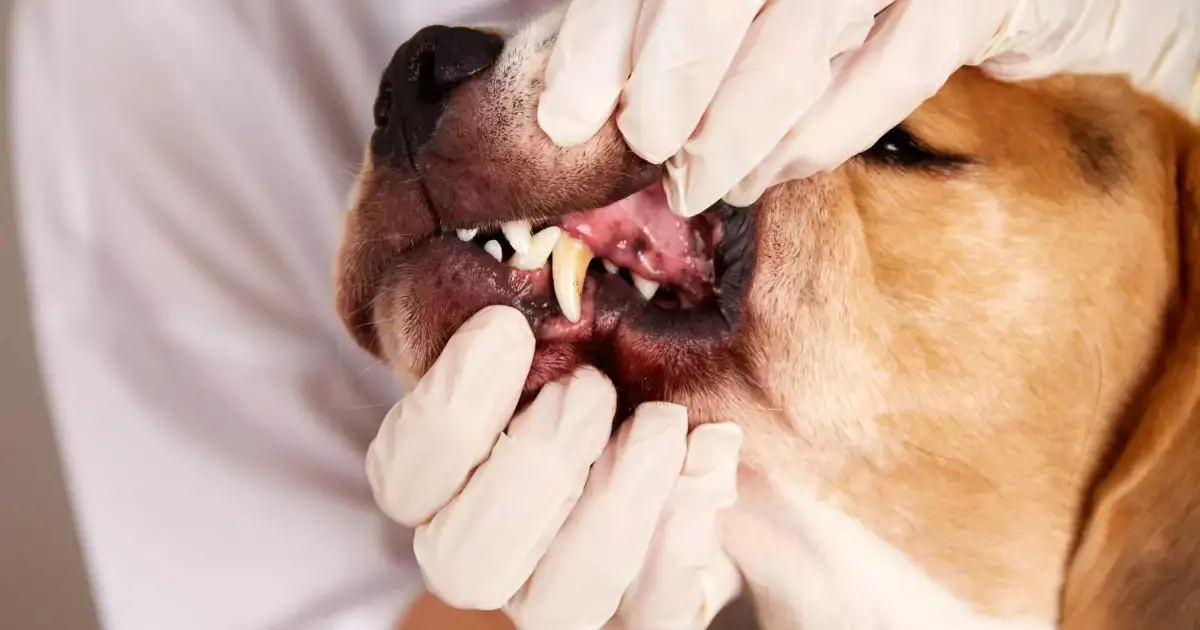Periodontal disease, commonly referred to as gum disease, is a prevalent health issue among dogs, affecting a staggering 80% of canines over three years of age. This inflammatory condition compromises the structures around a dog’s teeth, including the gums, periodontal ligament, and the supporting alveolar bone. The onset of periodontal disease is insidious, beginning with the accumulation of plaque, a soft, sticky film of bacteria. If left untreated, plaque hardens into tartar, ultimately leading to severe complications such as gum recession, infections, and potential tooth loss.
Stages and Symptoms of Periodontal Disease
Periodontal disease progresses through four distinct stages, each marked by specific clinical signs.
1. Stage 1: Gingivitis – This initial stage is characterized by inflamed, red, and swollen gums that may bleed easily when brushing or during chewing. Fortunately, gingivitis is reversible with appropriate dental hygiene practices.
2. Stage 2: Early Periodontitis – At this point, early attachment loss is evident as the gums recede, creating periodontal pockets. This stage often introduces bad breath, signaling a deepening issue.
3. Stage 3: Moderate Periodontitis – The deepening pockets lead to significant bone loss and possible mobility of teeth. Dogs may show visible signs of discomfort as the condition escalates, possibly avoiding food or exhibiting behavioral changes.
4. Stage 4: Advanced Periodontitis – The most severe stage involves extensive bone loss and pronounced periodontal pockets. Teeth may loosen significantly or even fall out. Dogs suffering from advanced periodontitis can experience severe pain, making it painful for them to eat and leading to systemic infections that can affect other organs.
Recognizing the symptoms of periodontal disease early can make the difference in treatment success. Subtle indicators—including bad breath, swollen gums, and visible tartar—should prompt immediate dental inspection. As the disease worsens, additional signs like loose teeth and abscesses may develop, underscoring the need for prompt veterinary attention.
The primary culprit behind periodontal disease is the accumulation of plaque and tartar. Bacterial biofilms establish themselves on tooth surfaces, activating a cascade of destructive responses if not addressed. Several factors can increase the likelihood of developing periodontal disease, such as:
– Age: Older dogs are significantly more susceptible due to accumulated exposure to plaque and tartar over their lifetime.
– Breed: Smaller breeds and those with crowded or misaligned teeth are particularly vulnerable to periodontal issues.
– Diet: A diet heavy in soft or sticky foods may promote plaque buildup.
– Poor Oral Hygiene: Inadequate care, including infrequent brushing and minimal veterinary dental interventions, exacerbates the risk.
Treating periodontal disease necessitates a comprehensive approach combining professional veterinary interventions with diligent home care. A veterinarian usually begins with a detailed oral examination and may utilize dental X-rays to evaluate the health of teeth and supporting structures underneath the gum line.
Key components of treatment may involve:
– Professional Dental Cleaning: Typically the first line of defense, this procedure removes plaque and tartar from above and below the gum line. Anesthesia is often required to ensure a thorough cleaning while minimizing stress for the dog.
– Antibiotics: If infection accompanies periodontal disease, antibiotic therapies might be prescribed to mitigate bacterial growth and inflammation. This becomes particularly vital in more advanced stages of the disease.
– Tooth Extraction: In cases where teeth are beyond saving due to severe damage, extraction can greatly improve the dog’s overall comfort and health.
– Surgical Solutions: Advanced cases may need surgical treatment to address deep pockets or restore lost bone structure. Options include flap surgery and bone grafting, contingent upon the severity of the disease.
Preventing periodontal disease is a far more manageable and less expensive alternative than treating established cases. Key preventive measures include:
– Regular Brushing: Daily tooth brushing, using a canine-specific toothbrush and toothpaste, is vital in maintaining oral cleanliness.
– Dental Chews and Toys: Providing specially designed dental chews can assist in reducing plaque while keeping gums healthy. Always look for products with the Veterinary Oral Health Council (VOHC) seal, verifying their effectiveness.
– Nutritious Diet: A balanced diet that supports oral health can curtail plaque buildup. Some dog foods are explicitly formulated to maintain better dental hygiene.
– Routine Veterinary Check-Ups: Regular dental examinations allow for early detection and intervention, helping avoid severe cases. At least one dental check-up per year is recommended.
While periodontal disease poses significant risks to a dog’s health and wellbeing, with vigilance and proper care, it is largely preventable. Understanding the stages, symptoms, causes, and treatment options is essential for any dog owner dedicated to their pet’s long-term health. Regular veterinary care, proactive dental hygiene, and awareness of changes in your dog’s oral health can protect them from this common yet serious condition.


Leave a Reply